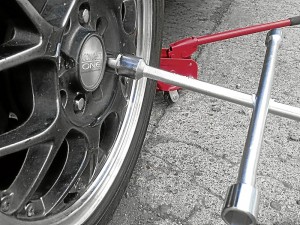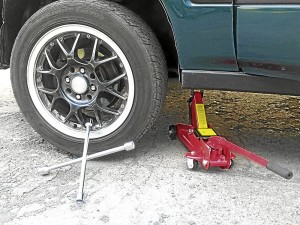Tire blowout no laughing matter
(Conclusion)
Boom! The explosive sound launched me and my four companions inside the car into screams. We thought someone had lobbed a grenade at us.
That was one of my most vivid recollections as a motoring reporter. That was 12 years ago, we were on a remote pass in Benguet Province test-driving an Asian Utility Vehicle (AUV). We also brought with us my old service pickup. I was designated captain of the AUV, and we were on our way back to Manila after an enjoyable trip to Sagada, Mountain Province. Then our two-vehicle convoy met a slow-moving, heavily laden 10-wheeler truck on the opposite direction. The pickup passed it without incident.
Then, a second later, when it was our turn to pass, the explosion happened.
It turned out that the truck’s 3-foot-high left rear tire suffered a side-wall blowout. The pneumatic force of the explosion was so strong that it deformed our AUV’s left fender, bent the hood upward and gouged out the left signal light. Fortunately, apart from the frazzled nerves, no one was hurt. But we gave quite a strange story in the accident report: a no-contact fender bender caused by an overinflated truck tire.

Most recently, another tire gave up on me near midnight on an isolated highway south of Manila. The front tire of my sedan ran over sharp metal debris, rupturing my treads. Again, presence of mind and proper replacement tires and tools saved the night.
Flat tires and blowouts exempt no motorist. It’s not a question of if, but when, and that “when” chooses no time, and airs no warning.
Not even the tire experts are spared from blowouts.
Mannix Ocampo, vice president for sales and marketing of GT Radial-Philippines, recounts a tire accident he would never forget.
“Once I had a road mishap on our way back home from Baguio. My rear right tire burst because I ran over the edge of a road being repaired in the NLEX. A big bus overtook my vehicle. It was a close shave that made me swerve my vehicle to the edge. The sharp edge hit the sidewall and the tire burst. Good thing I was just running 80 kph and I was able to control the vehicle. I immediately put on the hazard lights and slowly made my way to the shoulder of the highway.”
Ocampo said that once they were on the shoulder, his companions immediately helped to direct traffic, placing the early warning device (EWD) at a proper distance from the vehicle while waving a handkerchief, while he proceeded to change his tire.
Ocampo could be considered one of the luckier ones. Tire blowouts are many times the cause of vehicular accidents.
Several years ago, the Automobile Tire Defects of the American Jurisprudence, Proof of Facts, quoted the accident prevention division of Allstate Insurance Co. in its findings that almost 25 percent of fatal accidents on the highways are caused by tire troubles.
“When a blowout happens to you, stay calm, and maneuver your vehicle to the side of the road. The steering feel will change, so you will have to grip the steering wheel hard and steer to balance the vehicle. Most modern high-end vehicles will have traction control to do it for you. Again, it is much easier if you just perform preventive maintenance. When you experience a blowout, it could mean that you have been neglecting your tires, or the tires you have are not good. Replace them,” Sam Liuson, tire care expert and owner of Concept One Wheels, said.
Especially during this summer season, when more families would go on long road trips, the extra attention paid to tires could be well worth it.
Ocampo added that the higher roadside temperatures during summer can play a crucial role on tire performance and longevity.
“Temperatures can rise to as high as 40 degrees C. And we know what heat can do. Wear and tear is directly proportional to the temperature: the higher the temperature, the higher the wear and tear. Add to that the road surface temperature and you have compounded the effect.”
Ocampo explained that air pressure is likewise directly proportional to temperature. High temperatures expand air pressure as much as 23 percent. Management of tire inflation, therefore, is important. Check out your tire sidewall, which will guide you how much pressure you should put into your tires.
Liuson added that cracks in your tires are always bad news.
“These cracks can cause blowouts any time, especially when you are traveling fast and your tires are heating up. You can scrimp on a paint job, but you ought not to scrimp on tires.”
Ocampo suggested using nitrogen gas for inflation instead of ordinary compressed air. Nitrogen, he explained, is cooler compared to ordinary air. The coefficient of expansion is higher, which means less expansion and cooler runs. Nitrogen molecules are less massive than oxygen molecules, which translates to less load stress, and even leading to better fuel economy. Nitrogen, however, has bigger molecules than oxygen, which means better stability in inflation pressure, leading to better tread wear and better mileage for your tires.
Retreads or brand-new ones?
Ocampo said that despite the more expensive selling price, he would still recommend a brand-new tire over a retread tire. Retreads, he said, are prevalent and considered characteristic of underdeveloped and developing economies. They provide low-cost extension of tire life.
“Since safety standards are very important, many developed or First World economies have set retreading aside. A stricter tread depth standard is adopted even if there is a considerable depth remaining. This has led to the selling of used tires to developing and underdeveloped economies,” Ocampo said.
“For some markets, re-grooving tires is practiced especially on commercial tires. You may notice that tires are marked now with ’re-groovable.’ Such a practice adds a few millimeters more on the tread depth that can give extra mileage and maximize tire costs.”
Ocampo also shared these reminders:
•Choose tires that suit your usage
•Do not use repaired or damaged rims
•Rotate your tires regularly, including your reserve tire
•Check and maintain your vehicle’s mechanical aspects—alignment, camber, and brakes
•Check your tire pressure daily and maintain the suitable inflation pressure; use nitrogen over ordinary compressed air when possible
•Follow speed limits
•Change your driving habits; be a disciplined motorist
“Do these things and you will experience the performance level of your tire. Consequently, you will reap the rewards and discover value for money.”

